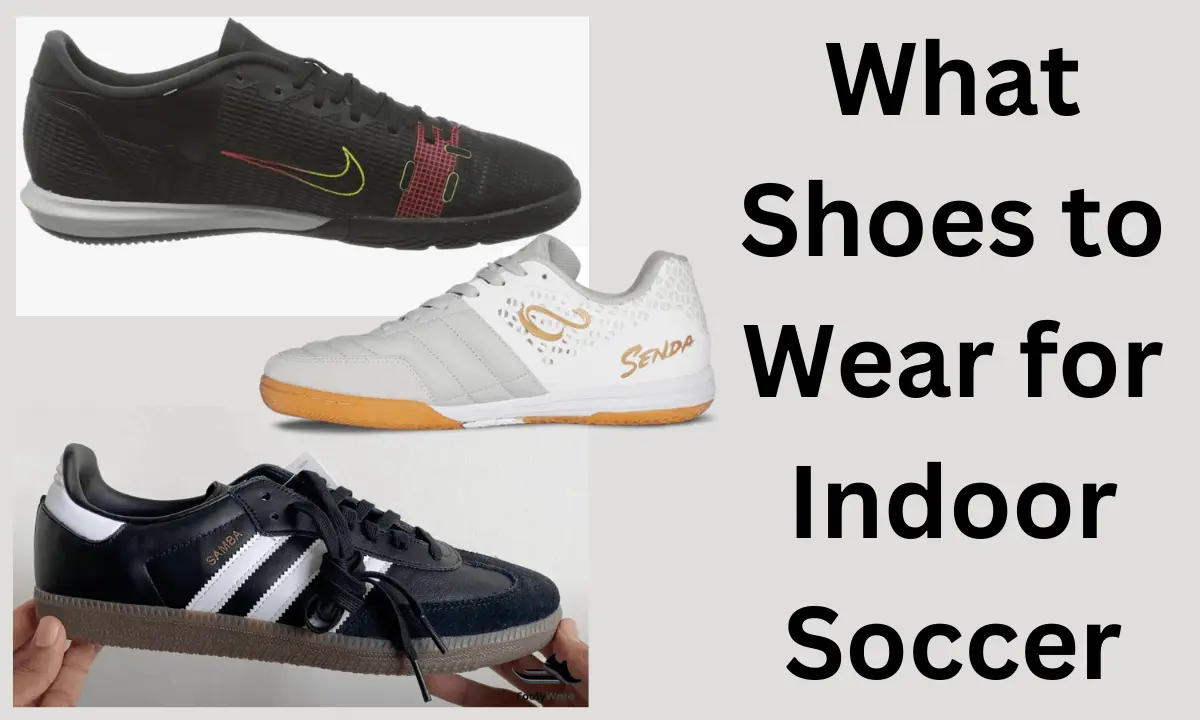What Shoes to Wear for Indoor Soccer

Selecting the right indoor soccer shoes can make the difference between sliding into defeat and sprinting toward victory. Whether you’re a weekend warrior or aspiring professional, this comprehensive guide will help you navigate the world of indoor soccer footwear with confidence.
Why Indoor Soccer Shoes Matter
Indoor soccer demands quick pivots, explosive acceleration, and precise ball control on unforgiving surfaces. Unlike outdoor grass where cleats dig into soft ground, indoor soccer shoes must provide traction through specialized rubber compounds and sole designs.
The wrong footwear doesn’t just hurt performance—it increases injury risk. Studies show that improper indoor footwear contributes to ankle sprains, knee injuries, and falls due to inadequate grip or excessive traction.
Key benefits of proper indoor soccer shoes:
- Enhanced ball touch and control
- Superior grip without surface damage
- Reduced injury risk
- Improved agility and quick direction changes
- Better shock absorption on hard surfaces
Types of Indoor Soccer Surfaces
Understanding your playing surface is crucial for selecting appropriate footwear. Each surface type demands specific sole technologies:
Hard Court Surfaces
Examples: Gymnasium floors, basketball courts, polished concrete Surface characteristics: Smooth, non-abrasive, requires non-marking soles Best shoe type: Futsal shoes or flat-soled indoor soccer shoes
Hard courts are the most common indoor soccer surface, offering consistent ball bounce and player movement. These surfaces require shoes with flat rubber outsoles that provide grip without leaving marks.
Artificial Turf Fields
Examples: 3G turf, synthetic grass with rubber infill Surface characteristics: Firm base with artificial grass fibers Best shoe type: Turf shoes with short studs or AG (Artificial Ground) cleats
Modern artificial turf closely mimics natural grass but maintains consistent conditions regardless of weather. The firmer base requires different traction patterns than natural surfaces.
Older Artificial Surfaces
Examples: AstroTurf, carpet-like synthetic surfaces Surface characteristics: Thin carpet over concrete, high abrasion Best shoe type: Turf shoes with dense rubber outsoles
These legacy surfaces are becoming less common but still exist in many facilities. They’re particularly demanding on footwear due to their abrasive nature.
Indoor Soccer Shoe Categories Explained
Futsal Shoes
Best for: Hard courts, gymnasium floors Key features:
- Completely flat rubber outsole
- Non-marking sole compound
- Lightweight construction
- Enhanced ball feel
- Superior lateral support
Futsal shoes represent the gold standard for indoor soccer on hard surfaces. Their flat design maximizes contact with smooth floors, providing excellent grip for quick cuts and stops.
Turf Shoes (TF)
Best for: Artificial turf, outdoor training Key features:
- Multiple small rubber studs
- Durable upper construction
- Even pressure distribution
- Enhanced durability
- Versatile traction pattern
Turf shoes bridge the gap between indoor and outdoor play, featuring dozens of small rubber studs that provide traction on artificial surfaces without excessive grip.
Artificial Ground Cleats (AG)
Best for: Third-generation artificial turf Key features:
- Shorter conical studs
- Strategic stud placement
- Reduced injury risk on firm surfaces
- Optimized for synthetic grass
- Professional-level performance
AG cleats represent the evolution of turf footwear, designed specifically for modern artificial grass installations found in professional facilities.
Indoor Cleats (IC)
Best for: Multi-surface indoor play Key features:
- Hybrid sole design
- Minimal stud height
- Versatile performance
- Suitable for various indoor surfaces
- Budget-friendly option
Indoor cleats offer a compromise solution for players who encounter multiple surface types, though they may not excel on any single surface type.
How Playing Position Affects Shoe Selection
Your position on the field influences the demands placed on your footwear. Here’s how to choose based on your role:
Forwards and Wingers
Primary needs: Speed, agility, ball touch Recommended features:
- Lightweight construction
- Thin upper materials for enhanced ball feel
- Flexible sole for quick direction changes
- Snug fit for precision control
Speed merchants need shoes that feel like extensions of their feet, prioritizing lightweight construction and superior ball touch over maximum protection.
Midfielders
Primary needs: Versatility, comfort, durability Recommended features:
- Balanced construction
- Good cushioning for constant movement
- Durable materials for extended wear
- Reliable traction in all directions
Box-to-box players need versatile footwear that performs well in various situations, from defensive tackles to attacking runs.
Defenders
Primary needs: Stability, protection, durability Recommended features:
- Reinforced construction
- Enhanced ankle support
- Durable materials
- Reliable grip for sudden stops
- Protection against impacts
Defensive stalwarts benefit from shoes that prioritize protection and stability over lightweight construction, helping them win challenges and maintain positioning.
Goalkeepers
Primary needs: Grip, stability, lateral movement Recommended features:
- Maximum traction for quick saves
- Stable platform for jumping
- Durable construction for sliding
- Comfortable fit for long periods
- Non-slip sole pattern
Shot-stoppers need footwear that provides a stable base for explosive movements while maintaining grip during lateral dives and quick reflexes.
Top Indoor Soccer Shoes
Adidas Samba Classic
Best for: All-around indoor performance Price range: $70-90
The Samba remains the benchmark for indoor soccer shoes, combining premium kangaroo leather construction with time-tested design. Its flat gum rubber outsole provides exceptional grip on hard courts while the leather upper offers superior ball feel and durability.
Pros:
- Excellent ball touch and control
- Durable kangaroo leather construction
- Classic, versatile styling
- Proven performance across skill levels
- Reasonable price point
Cons:
- May feel narrow for wider feet
- Break-in period required
- Limited color options
SENDA Ushuaia Pro 2.0
Best for: Comfort-focused players Price range: $80-110
The Ushuaia Pro 2.0 prioritizes comfort without sacrificing performance, featuring breathable synthetic materials and excellent cushioning systems. This shoe excels for players who spend long hours on indoor courts.
Pros:
- Exceptional comfort from first wear
- Breathable upper materials
- Excellent grip on multiple surfaces
- Good value for performance
- Available in multiple colorways
Cons:
- Visible wear after extended use
- Longer break-in for optimal ball feel
- Limited availability in some regions
Nike Mercurial Vapor Academy IC
Best for: Speed-focused attackers Price range: $65-85
Nike’s indoor adaptation of their popular Mercurial line delivers lightweight performance with responsive touch. The synthetic upper provides consistent ball contact while maintaining the explosive feel of the outdoor version.
Pros:
- Ultra-lightweight construction
- Responsive ball touch
- Modern, athletic styling
- Good traction on clean courts
- Wide availability
Cons:
- Less durable than leather alternatives
- Not suitable for abrasive surfaces
- May lack support for some players
Puma Future Z 4.1 IT
Best for: Creative playmakers Price range: $60-80
The Future Z brings innovative design to indoor soccer, featuring adaptive fit technology and creative traction patterns. This shoe caters to players who value unpredictability and flair in their game.
Pros:
- Adaptive upper fits various foot shapes
- Creative control elements
- Good value proposition
- Distinctive styling
- Suitable for artificial turf transition
Cons:
- Unconventional fit may not suit everyone
- Newer brand in indoor soccer market
- Limited long-term durability data
Buying Guide: What to Look For
Fit and Sizing
Proper fit is paramount for indoor soccer shoes. Unlike casual footwear, soccer shoes should fit snugly without being uncomfortable. Here’s what to consider:
Sizing tips:
- Try shoes on in the afternoon when feet are slightly swollen
- Ensure minimal heel slip
- Check for pressure points around the midfoot
- Allow thumb-width space between longest toe and shoe end
- Consider sock thickness you’ll wear during play
Material Considerations
Leather advantages:
- Superior ball feel
- Natural stretch and comfort
- Excellent durability
- Classic appearance
- Better in wet conditions
Synthetic advantages:
- Consistent performance
- Lower maintenance
- Often lighter weight
- More color options
- Usually less expensive
Sole Technology
The outsole represents the most critical performance element of indoor soccer shoes. Look for:
Rubber compound: Non-marking formulations that provide grip without leaving residue Tread pattern: Designed for multidirectional movement and quick stops Flexibility: Allows natural foot movement during play Durability: Withstands abrasive indoor surfaces
Budget Considerations
Indoor soccer shoes range from $40 to $200+, with most quality options falling between $60-120. Consider these factors:
Entry level ($40-70): Suitable for casual players, basic construction, synthetic materials Mid-range ($70-120): Best value for regular players, good materials, proven designs Premium ($120+): Professional-level construction, premium materials, latest technology
Maintenance and Care Tips
Proper care extends shoe life and maintains performance:
After Each Session
- Remove excess dirt and debris
- Air dry at room temperature
- Stuff with newspaper if very wet
- Rotate between multiple pairs when possible
Weekly Maintenance
- Clean with mild soap and water
- Check sole wear patterns
- Inspect upper for damage
- Apply leather conditioner if applicable
Storage Tips
Replace when sole wear affects gripg your mark on the game, not the floor. So lace up, step onto the court, and dominate the competition!
Store in ventilated area
Use shoe trees for leather models
Keep away from direct heat sources
FAQs of What Shoes to Wear for Indoor Soccer
Final Thoughts
Choosing the right indoor soccer shoes is an investment in your performance, comfort, and safety. Whether you’re dominating recreational leagues or training for competitive play, the perfect pair of indoor soccer shoes will enhance your game while protecting your feet.
Remember that the best shoe is the one that fits your foot, matches your playing surface, and suits your style of play. Take time to research, try different options, and invest in quality footwear that will serve you well on the court.
Ready to elevate your indoor game? Start with the right foundation—choose indoor soccer shoes that turn every touch into an opportunity and every step into an advantage.
